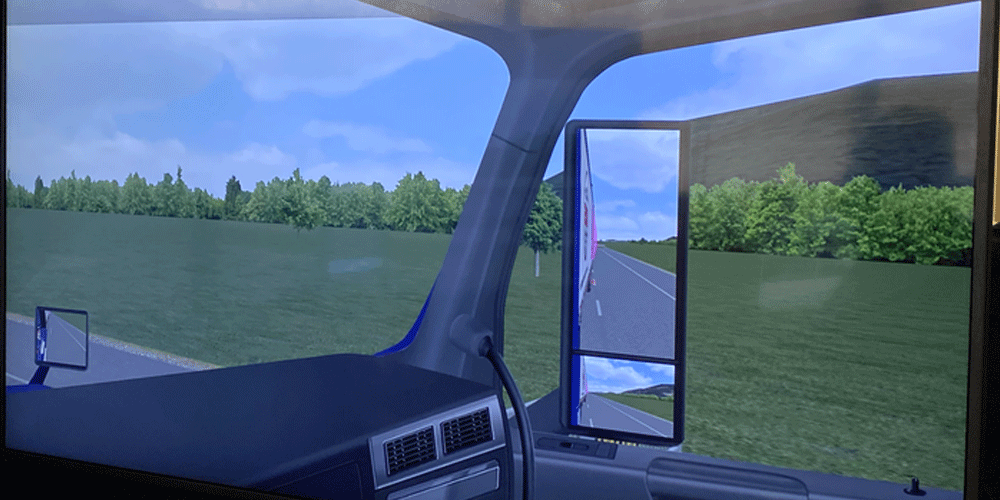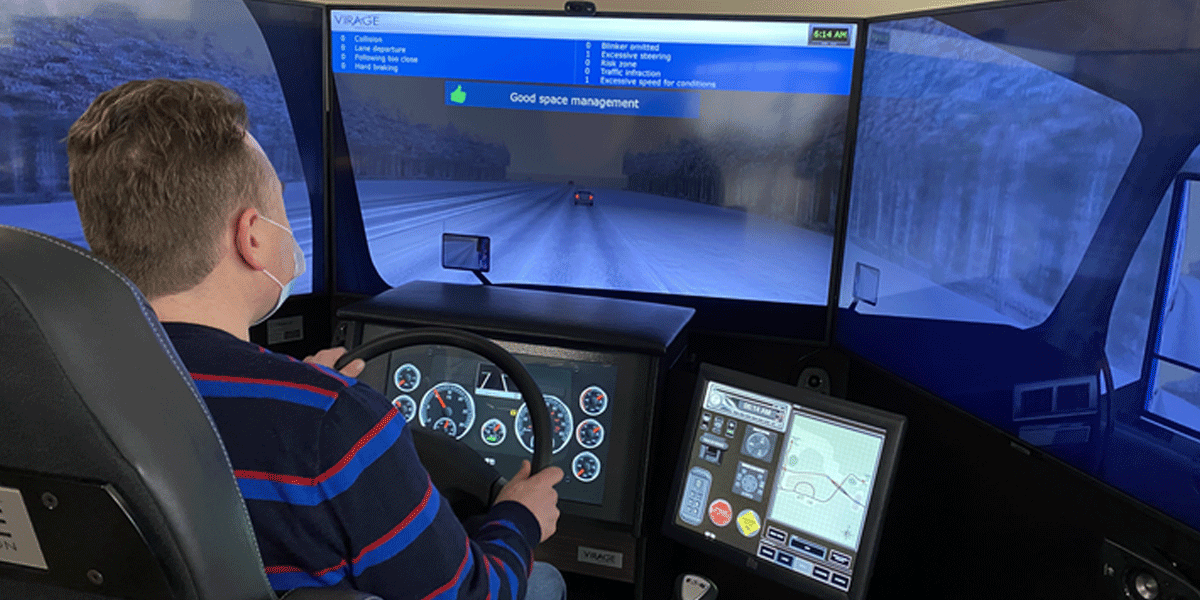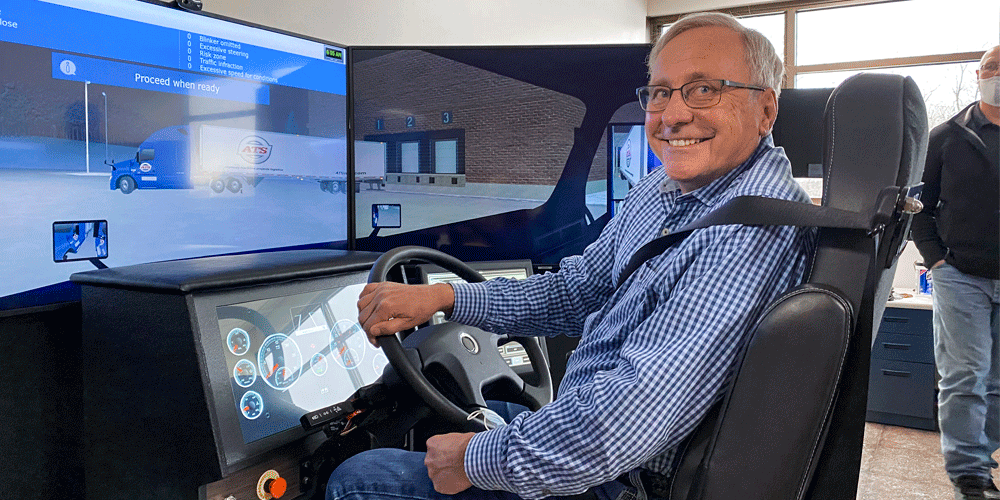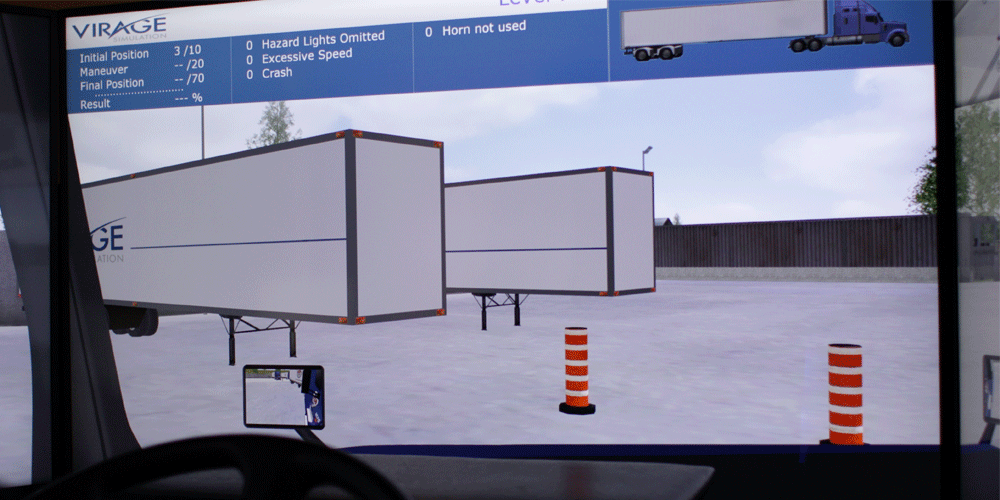CDL Simulators: What are They and Why Do Carriers Use Them?
John joined the ATS team in 2020 as the safety and technology manager. He’s responsible for implementing the Lytx program with ATS and its affiliate companies and ensuring ongoing compliance. He is also responsible for the operation of the driving simulators. From drivers, to operations, shop staff, driver managers and leaders, he appreciates that his position gives him the opportunity to work with a lot of great people within the ATS Family. Before coming to ATS, he spent 32 years in the telecommunications industry as operations and installation quality building out large carrier cellular and data networks.
Have you ever been a bit worried about your skills behind the wheel? Maybe you’re new to driving and you aren’t sure if your skills are up to par. Maybe you’re a veteran driver who is looking to brush up on your skills and learn a few new things. CDL (commercial driver's license) simulators are designed to help simulate the truck driving experience. This allows you to safely practice your skills no matter what part of the journey you're in.
However, there's some controversy surrounding simulators. Some companies are using them to replace behind-the-wheel training entirely and some drivers don't like simulators at all.
I work as a safety technology manager at Anderson Trucking Service (ATS), so part of my job is to make sure our fleet prioritizes safety by implementing effective technology.
In this article, I’ll explain:
- What a truck simulator is
- Key features and benefits of the simulators
- How simulators improve your skills
What is a CDL Simulator?
A CDL simulator, or a truck driver training simulator, is an advanced training tool designed to replicate the experience of driving a commercial vehicle. CDL simulators use computer-generated environments and realistic vehicle controls to create a virtual driving experience that closely mirrors real-world conditions. The simulator has all the primary functions that your Class 8 truck’s dashboard would have, but instead of being out on the road, you have several screens in front of you. The ignition, the gears, the steering wheel with your horn, and turn signals — it’s all there.
The simulator feels like a real semi-truck. It moves, tilts, and vibrates. If you were to hit something during a simulation or run over a curb, you would feel it. It also simulates the feel of the road — whether the road is bumpy or snow-covered. Because it can simulate the feel of the road during inclement weather, it’s an especially helpful tool for drivers who have never driven in snow but will have to in the future.
Truck simulator equipment can be set up as different truck models. Depending on what division you’re in at your company, you can learn in the simulator with a dry van load or a flatbed load. Simulators are utilized in numerous industries. There are airplane simulators, dump truck simulators, construction equipment simulators, and more.
CDL Simulator Features and Benefits
CDL simulators are widely used by trucking companies and trucking schools to train new drivers or to help experienced drivers improve their skills. They're a valuable tool for enhancing safety, efficiency, and confidence behind the wheel.
The truck simulator is designed to enhance your skills, so it should be more difficult to drive the simulator than your semi-truck out on the road. The simulator can be tailored to be more rigorous than a semi itself. For example, shifting may be more precise when drivers are learning how to operate a manual transmission. An hour in the simulator is comparable to two or three hours out on the road. The simulator tests your skillset and builds your knowledge base, so it requires extreme concentration.
Some of the other benefits include:
- Risk-Free Learning: Drivers (especially new ones) can make mistakes and learn from them without the potential for costly accidents or injuries.
- Repetition and Mastery: Simulators allow for repetitive practice of specific skills and maneuvers, like backing up, turning, parallel parking, fuel-efficient driving, and emergency techniques. This can help build muscle memory and the confidence to handle these maneuvers on the road.
- Customized Training: Instructors can tailor the simulator experience to focus on areas where a driver needs the most practice, such as nighttime driving or adverse weather conditions.
- Improved Safety: Simulator training reduces the risk of accidents by allowing drivers to practice hazardous scenarios in a safe setting. This allows drivers to make mistakes and learn from them.
- Cost-Effective: Simulators are more affordable than trucks and their associated maintenance costs.
Your simulator sessions are recorded and you’ll receive numeric feedback when completed. Your instructor can review your progress and observe your driving behaviors during the tests. There is also a camera in the simulator to observe things like whether or not you looked in your mirrors. After you go through the various scenarios, you can sit down with your instructor and talk through best practices and tips for success.
Keep in mind: The numeric feedback isn't used against you and it's not used to dock your pay. It’s used to help your instructor understand where you could refine your skills.
How Does CDL Simulator Training Improve My Trucking Skills?
CDL simulators are a great training tool. Because of this, they can be used for new drivers and veteran drivers. In fact, some training companies even utilize them heavily in their CDL training programs and have a dozen or more drivers using them at once.
A truck simulator is used in three primary ways:
- In orientation
- After an accident
- To break long-lasting habits
Practice Your Skills In Orientation
CDL simulators are often used in driver orientation. New drivers attend orientation at trucking companies every week and, while every company is different, many companies have their drivers take a road test and simulator training.
Drivers go through scenarios on the simulator to assess different skills and behaviors, including backing, turning, braking, intersection behaviors, tight maneuvering, and hazard perception. The simulator measures your ability in each of these areas.
If there is a section of the assessment that you aren’t strong in — let’s say your backing skills need some work — your instructor will teach you valuable strategies to improve your skills. They’ll also take you through another road test to ensure you meet the minimum orientation requirements to drive for the company.
The simulator can also be very helpful if you’re switching from van driving to flatbed driving or vice versa.

Train On Your Problem Areas Following an Accident
If you’ve had an accident, getting in the truck simulator is the perfect opportunity to take some time to practice those skills that may have led to the accident. If you have a dash cam in your truck, your instructor can review areas of improvement or behaviors that nearly led to accidents. Then you can work on those behaviors in the simulator.
Training in the CDL simulator following an accident will not only improve your confidence when driving in those scenarios, but it’ll also help keep you safer on the road and prevent costly accidents.
Speeding and following too closely are common causes of accidents out on the road. Rear-end accidents can be among the most severe. The simulator can take you through activities that teach you to open up the space cushion in front of you and improve your perception and cognitive response. It’ll also help improve your feel for how long it takes the brakes to activate and the distance it takes to stop.
Perhaps one of the most important features of the simulator is that it offers you the option to pull off the road. Not only will it help you learn how to handle your truck in slippery, snowy conditions, but it can also help you learn when the conditions are so poor that you must pull off the road.
As you progress, your instructor will pick certain scenarios they want you to go through to hone your skills.
Improve Your Skillset After Years On The Road
Even drivers who have been in the industry for decades find that the truck driving simulator can help them improve their skills. As a driver, you build driving habits — some of which might not always be the safest. Getting in the simulator can help you look at those behaviors and improve upon them. Or, the simulator can help you become more efficient on the road with minor improvements.
Think of a professional athlete. A professional baseball player might have an excellent batting average, but that doesn’t mean he stops going to batting practice. As a professional baseball player and a professional driver, you have to continue to hone your skills to ensure you’re always at the top of your game and performing optimally.
Prevent Accidents Out On the Road
Truck driver simulator training is a great way to improve as a driver and test out driving scenarios you’ve never experienced. It gives you a safe environment to learn new strategies and improve your safety and efficiency.
Maybe you don’t have access to a truck simulator right now, but you’re still looking for new strategies to improve your performance and prevent accidents. These five accident prevention tips address some of the most common causes of accidents and how to hone your accident prevention skills.




